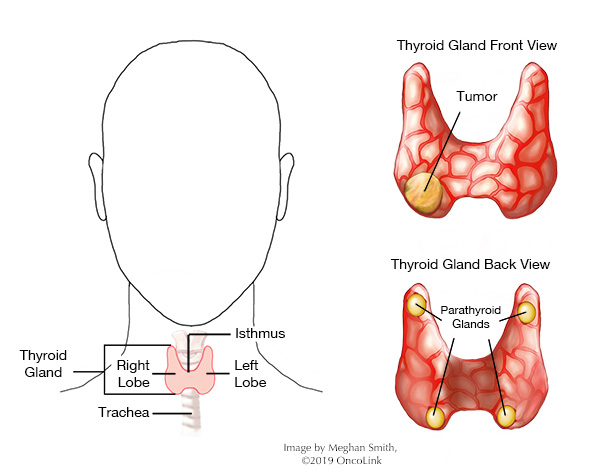Surgical Procedures: Surgery and Staging for Thyroid Cancer
Cancerous cells in the thyroid gland are called thyroid cancer. The thyroid gland is found at the base of the neck. It has a right and left lobe and is butterfly-shaped. The thyroid gland makes hormones that control many important body functions like:
- Heart rate and temperature control.
- Blood calcium levels.
- Metabolic function.
What is staging and how is it performed?
Staging is the process of learning how much cancer is in your body, where it is, and how far it has spread (metastasized). Thyroid cancer spreads to other parts of the body through the tissue, lymph, and blood systems. Staging can also help when deciding what treatment will be used.
Your provider will have you get a few tests to figure out the stage of your cancer. For thyroid cancer, these tests may include:
Physical Exam: This is a general exam to look at your body and to talk about past health issues.
Imaging: Radiology tests can look inside your body to look at the cancer and determine if it has spread. These tests can include:
- Ultrasound.
- CAT scan (CT scan).
- Positron emission tomography scan (PET scan).
- Magnetic resonance imaging (MRI).
Blood Tests: Blood samples can be used to check the levels of certain hormones and substances. These can include thyroid-stimulating hormone (TSH), calcitonin, anti-thyroid antibodies and/or calcium levels.
Procedures: These may include:
- Laryngoscopy: The larynx (voice box) is looked at using a mirror or laryngoscope to make sure the vocal cords are working correctly.
- Fine Needle Aspiration: Using a thin needle, thyroid cells are removed and checked for cancer.
- Surgical Biopsy: Removal of a thyroid nodule, lobe, or whole thyroid to check for cancer.
- Sentinel Lymph Node Biopsy: A radioactive or blue dye is injected near the cancerous tumor, which is absorbed by nearby lymph nodes. The first lymph node to display dye, the sentinel lymph node, is removed and tested for cancer.
A biopsy is not always able to determine if there is cancer present. You may need surgery to figure out if you have thyroid cancer.
Surgical Procedures Used for the Treatment of Thyroid Cancer
Surgery is often used to treat thyroid cancer. Surgical procedures used include:
- Lobectomy: Removal of the affected thyroid lobe. Lymph node biopsies may be done to check if cancerous cells are present.
- Near-total Thyroidectomy: Removal of almost the whole thyroid gland.
- Subtotal Thyroidectomy: Removal of most of the thyroid gland.
- Total Thyroidectomy: Removal of the whole thyroid gland.
- Lymphadenectomy: Removal of cancer-affected lymph nodes within the neck.
During the surgery, your surgeon will make an incision (cut) across the front of the neck, where the thyroid gland is found. The incision will be a few inches in length.
What are the risks of thyroid surgery?
As with any surgery, there are risks and possible side effects. These can be:
- Bleeding, which can lead to sudden trouble with breathing.
- Damage to the laryngeal nerve that can lead to your voice being hoarse.
- Parathyroid gland damage can cause hypoparathyroidism and low levels of calcium.
- Infection.
- Blood clots.
- Developing hypothyroidism (the thyroid not working well enough).
What is recovery like?
Recovery from a thyroid cancer surgery may include a stay in the hospital for 24-48 hours, with a return to normal activities often within the first day post-op. You will be told how to care for your incision before leaving the hospital.
Your medical team will review the medications you will be taking, such as those for pain and/or to treat hypothyroidism.
Your provider will talk to you about any activity restrictions you will have after surgery.
How can I care for myself?
You may need a family member or friend to help you with your daily tasks until you are feeling better.
Be sure to take your prescribed medications as directed to prevent pain, infection, and/or constipation. Call your team with any new or worsening symptoms.
There are ways to manage constipation after your surgery. You can change your diet, drink more fluids, and take over-the-counter medications. Talk with your care team before taking any medications for constipation.
Taking deep breaths and resting can help manage pain, keep your lungs healthy after anesthesia, and promote good drainage of lymphatic fluid. Try to do deep breathing and relaxation exercises a few times a day in the first week, or when you notice you are extra tense.
- Example of a relaxation exercise: While sitting, close your eyes and take 5-10 slow deep breaths. Relax your muscles. Slowly roll your head and shoulders.
This article contains general information. Please be sure to talk to your care team about your specific plan and recovery.
